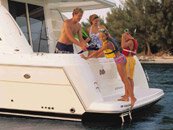Sails work by “catching the wind” only when the boat is sailing downwind. The rest of the time, a sail is essentially an airplane wing standing on end, and works the same way.
Sailing for Beginners
- When properly trimmed (adjusted or positioned), the sail’s leading edge—the luff—points into the wind, creating higher pressure on the windward side (the side facing the wind) and lower pressure on the leeward side (the side away from the wind)."
- The sail “lifts,” or moves, toward the lower-pressure side causing the boat to move. This happens because the sail isn’t a flat sheet of cloth, it’s curved, like a wing and the air traveling over the topside of the curved portion travels faster than that traveling on the underside. (The curvature, or “draft,” is built-in by the sailmaker, through careful cutting and sewing of the narrow panels that make up the sail.)
- Not all of the lift developed by a sail moves the boat ahead. Since the direction of lift is roughly at right angles to the sail, some of it tries to pull the boat sideways, too—but the shape of the hull and keel combined with the rudder creates a high resistance to the sideways force, "driving" the boat ahead.
- How much of the total lift acts to pull the boat forward and how much sideways depends on the “point of sail,” the angle between the boat and the wind: Closer to the wind = more sideways component, because the sail is trimmed in closer to the centerline of the boat.
Because of this, when “beating” into the wind, most sailboats move a little bit sideways as well as ahead. Sailors call this “making leeway,” and always take it into account when navigating or sailing in close quarters.
To learn more, check out Beginner Sailing Tips, and to get hands-on sailing instructions, visit a sailing school near you!
Explore Sailboat Types & Manufacturers


